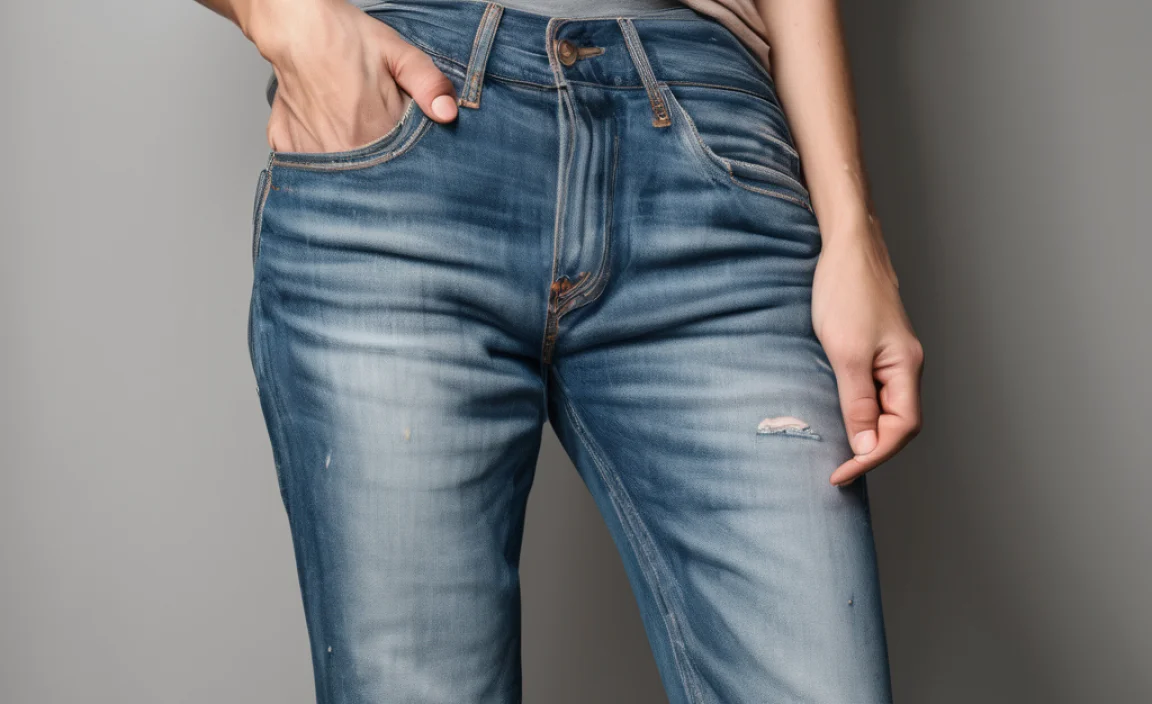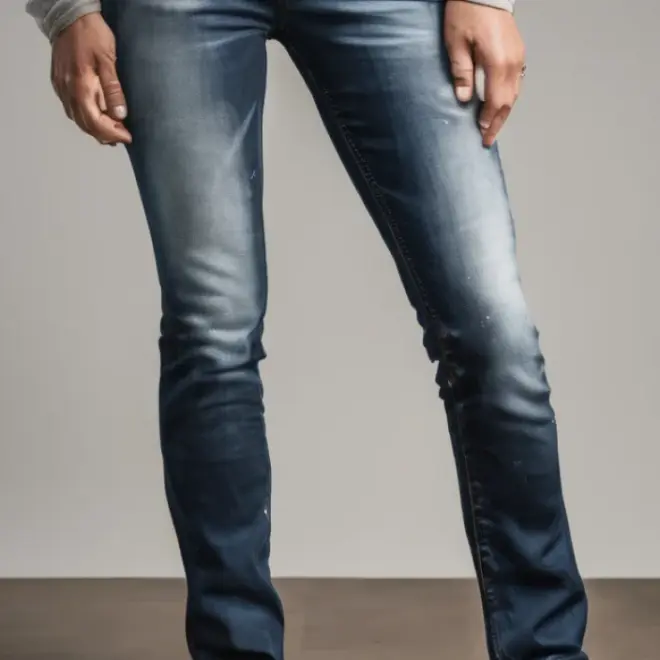Hemming your boyfriend jeans with shampoo is a simple, mess-free way to achieve a cleaner, shorter look for your favorite denim without needles or sewing machines. This guide shows you how to get a perfect, no-fray hem in minutes.
Ever found yourself staring at your favorite pair of boyfriend jeans, wishing they were just a little shorter? Maybe they’ve stretched out a bit, or perhaps the original hem is looking a little tired. The thought of hemming can send many of us running for the hills, picturing complicated sewing machines or irreversible mistakes. But what if I told you there’s a surprisingly simple and effective method that requires no stitches, no fabric glue, and very little fuss? You can achieve a neat, customized hem on your boyfriend jeans using something you likely already have in your bathroom: shampoo. Yes, you read that right! This method is perfect for a quick fix, a temporary adjustment, or even a permanent change to the length of your beloved denim. We’ll walk through this easy, beginner-friendly process step-by-step, so you can get back to enjoying your perfectly fitting jeans in no time.
Why The Shampoo Method Works for Hemming Denim

It might sound a bit unusual, but the shampoo method for hemming denim, particularly looser styles like boyfriend jeans, leverages the properties of certain shampoos to create a temporary, yet remarkably effective, bond. The magic lies in the surfactants and conditioners often found in shampoo. When applied to the frayed edge of a denim hem, these ingredients can temporarily stiffen and bind the fibers together. This creates a cleaner line, much like a natural fray or a very subtle cuff, without the need for actual sewing. It’s a temporary solution, but it’s astonishingly good at giving your jeans a polished look. Unlike permanent hemming techniques, this method is reversible and incredibly forgiving. You don’t need to worry about making mistakes that you can’t fix, making it an ideal approach for beginners or those who like to experiment with their style.
The Unexpected Benefits of Shampoo Hemming

Choosing the shampoo method for hemming your boyfriend jeans offers a unique set of advantages. For starters, it’s exceptionally budget-friendly. Most households already have shampoo readily available, eliminating the need to purchase special tools or materials. This makes it an accessible solution for anyone.;
- Cost-Effective: No need to buy hemming tape, special glues, or a sewing machine.
- Beginner-Friendly: Zero sewing skills are required, making it accessible to everyone.
- Reversible: If you decide you don’t like the result, a simple wash will remove the hold.
- Quick & Easy: The entire process can take less than 15 minutes.
- No-Fray Control: Effectively tames excessive fraying for a cleaner look.
- Natural Look: Creates a subtle, lived-in hem that complements the boyfriend jean style.
This method is particularly well-suited for boyfriend jeans because their relaxed fit and often distressed appearance can easily accommodate a slightly less structured hem than, say, a pair of tailored trousers. It’s about achieving a casual, stylish look with minimal effort. For more in-depth information on denim care and maintenance, the Federal Trade Commission (FTC) provides valuable insights into garment care labels, which can help you understand your clothing better.
Gathering Your Supplies

Before you begin transforming your jeans, ensure you have everything you need. The beauty of this method is its simplicity, meaning you likely won’t need to venture out to a craft store. Here’s what you’ll want to have on hand:
Essential Items:
- Your Boyfriend Jeans: The star of the show! Ensure they are clean and dry.
- Shampoo: A standard, good-quality shampoo will work best. Avoid overly watery or 2-in-1 shampoo/conditioner products, as they might not have enough binding power. A thicker, more concentrated formula tends to hold better.
- Scissors: Sharp fabric scissors are ideal for a clean cut if you need to trim any excess fraying or unevenness. If you’re just working with an existing hem, you might not need these.
- Measuring Tape or Ruler: To ensure your desired length is even on both legs.
- Fabric Marker or Chalk (Optional): For marking your desired hemline if you’re cutting the jeans shorter.
- A Damp Cloth or Sponge: For blotting away excess shampoo.
It’s worth noting that the type of shampoo can make a slight difference. While most will work, a shampoo with conditioning agents might provide a slightly stronger hold because these agents can help smooth and bind the denim fibers. For a deeper dive into fabric types and their properties, resources like Textile School offers comprehensive information on various textile fibers that can deepen your understanding of why certain methods work on denim.
Step-by-Step Guide: Hemming with Shampoo

Ready to get started? This process is straightforward and designed for absolute beginners. Follow these steps carefully, and you’ll have perfectly hemmed boyfriend jeans sooner than you think.
Step 1: Determine Your Desired Length
Put on your boyfriend jeans and stand in front of a mirror. Decide where you want the hem to fall. Boyfriend jeans typically have a more relaxed, sometimes cuffed or intentionally frayed hem, so you have some flexibility. If you’re shortening them, use your measuring tape or ruler to mark the new hemline on the inside of each leg. You can use a fabric marker or chalk for this, or simply use your fingernail to create a crease. Ensure the marked length is consistent on both legs to avoid an uneven hem.
Step 2: Prepare the Hem Area
If your jeans aren’t already frayed at the bottom, you might want to create a subtle fraying for a more authentic boyfriend jean look, or simply ensure the existing hemline is clean. If you’re cutting them, make your cut along the marked line. For this method, we’re primarily focusing on managing an existing hem or a slightly frayed edge. If the original hem is still intact and you want to shorten them, you can either carefully cut off the original hem or, if you’re feeling adventurous and want a quick fix, you might be able to fold them up to your desired length and apply the shampoo without cutting. For the most effective results when shortening, it’s best to cut off the excess fabric first.
Step 3: Apply the Shampoo
This is where the magic happens! Take a generous amount of your chosen shampoo and apply it directly to the frayed edge or the area where you want the hem to “stick.” Work it in slightly with your fingers, ensuring all the denim fibers at the very edge are coated. You want enough shampoo to saturate the threads, but not so much that it’s dripping excessively. The shampoo acts as a temporary binder, helping to hold the fibers in place and prevent further fraying or unraveling.
Step 4: Shape and Set the Hem
Once the shampoo is applied, use your fingers to smooth and shape the hem to your desired look. If you want a sharp, clean edge, press it firmly. If you prefer a slightly softer, more natural-looking hem, gently tousle the fibers. For this method, often the best approach is to gently fold the hem up to your desired length and press with your fingers, allowing the shampoo to help set that fold. You can also try to lightly bunch or scrunch the very bottom edge to encourage a natural-looking fray control. The goal is to create a defined line where the denim fibers are less likely to spread apart.
Step 5: Allow to Dry
This is a crucial step for the shampoo to do its work. Let your jeans air dry completely. You can let them lie flat, hang them, or even wear them loosely while they dry, as long as you don’t disturb the hem too much. Drying time will vary depending on the humidity and the amount of shampoo used, but it typically takes a few hours. Avoid using a dryer, as the heat can sometimes alter the shampoo’s binding properties in unpredictable ways. Patience here will ensure a more durable result.
Step 6: Assess and Refine (Optional)
Once the jeans are fully dry, check the hem. It should feel somewhat stiffened and hold its shape. If you’re happy with the result, congratulations! You’ve successfully hemmed your boyfriend jeans. If the hem feels too stiff, you can gently rub it with your fingers to soften it. If it’s not holding as firmly as you’d like, you can repeat the shampoo application and drying process. For a very clean finish, you might want to trim any stray threads that didn’t bind. A slightly damp cloth can help catch loose fibers as you trim. Remember, this is a temporary solution, so it might need a refresh after a few washes.
Troubleshooting Common Issues

While the shampoo hemming method is generally forgiving, like any DIY technique, you might encounter a few hiccups. Here’s how to address some common challenges:
Hem Not Holding Firmly
Cause: Not enough shampoo was used, or the shampoo formula was too watery.
Solution: Apply another layer of shampoo, ensuring it saturates the fibers well. Let it dry completely. You might also try a different brand of shampoo with a thicker consistency.
Hem Feels Too Stiff
Cause: Too much shampoo was applied, or the shampoo has a very strong hold.
Solution: Gently massage the hem with your fingers to soften it. You can also try lightly dampening the hem with water and then gently working it with your hands. If it’s still too stiff, a quick wash will remove the shampoo entirely, and you can reapply a smaller amount.
Uneven Hem
Cause: Inconsistent application of shampoo or uneven drying.
Solution: If the hem is uneven after drying, you can carefully trim the excess with sharp fabric scissors to create a uniform line. For future attempts, pay close attention to consistent application and ensure the jeans are hanging or lying evenly while drying.
Excessive Fraying Continues
Cause: The shampoo didn’t bind the fibers effectively enough, or the original fraying was severe.
Solution: This method is best for managing moderate fraying or creating a clean cut edge that won’t unravel further. For very extensive fraying, you might need to trim back to a more stable fabric layer before applying the shampoo. If you want to permanently prevent fraying, you may need to consider sewing. For understanding different types of fabric finishes and how they affect wear, consult specialized textile guides.
When to Use the Shampoo Method (And When Not To)
The shampoo method for hemming boyfriend jeans is a fantastic quick-fix, but it’s good to know its limitations. Understanding when this technique shines and when it’s best left for another day will help you achieve the best results.
Best for:
- Temporary Adjustments: Need your jeans to be shorter for a specific event or season? This is perfect.
- Managing Mild Fraying: If your hem is starting to look messy but isn’t completely unraveling.
- Beginners: Anyone intimidated by sewing or fabric glue.
- Casual Styles: Boyfriend jeans, relaxed-fit denim, or even shorts where a slightly imperfect hem is part of the aesthetic.
- No-Sew Projects: When you don’t have access to sewing tools or supplies.
Not Ideal for:
- Permanent Hemming on Tailored Garments: For structured pants or jeans where a crisp, permanent hem is required, sewing is the best option.
- Heavy-Duty Wear: If your jeans are subjected to very rough wear or frequent high-heat washing, the effect of the shampoo may not last long.
- Very Thin or Delicate Fabrics: This method works best on sturdy denim.
- Significant Length Conversions: If you need to shorten jeans by a large amount (e.g., more than 4-5 inches), it’s better to cut and hem properly.
For those interested in understanding different garment construction techniques, the Fashion History Timeline offers insights into historical clothing construction methods, which can provide context for why certain modern methods are used.
Comparing Shampoo Hemming to Other Methods
It’s always helpful to see how a new technique stacks up against more traditional ones. Here’s a quick look at how shampoo hemming compares:
| Method | Pros | Cons | Best For |
|---|---|---|---|
| Shampoo Hemming | Cost-effective, quick, no sewing, reversible, beginner-friendly. | Temporary, may need reapplication, not ideal for perfect crisp hems, can be stiff. | Casual styles, temporary fixes, managing fray. |
| Sewing Machine Hemming | Permanent, professional finish, strong hold. | Requires sewing machine, skill, time; can be difficult to alter later. | Permanent hemming, all garment types, tailored looks. |
| Hand Sewing (Hemming Stitch) | Permanent, precise control, portable (no machine needed). | Time-consuming, requires practice for neatness. | Permanent hemming, alterations, delicate fabrics. |
| Fusible Webbing/Hem Tape | No-sew, relatively strong hold, quick alternative to actual sewing. | Can be stiff, may unstick with washing/drying, visible from inside if not applied carefully. | Quick permanent-ish fixes, repairing existing hems. |
| Fabric Glue | No-sew, strong bond, flexible. | Can be messy, requires precise application, might dry stiff or leave residue, permanent. | Permanent no-sew fixes, heavier fabrics. |
As you can see, each method has its place. The shampoo method excels when simplicity, speed, and a temporary solution are key. For boyfriend jeans, a style that often embraces a more relaxed aesthetic, this method is a perfect fit for when you want a quick tidy-up of the hemline without commitment.
Caring for Your Shampoo-Hemmed Jeans
Once you’ve achieved your desired hem with the shampoo method, a little care will help maintain the look. Since this is a temporary fix, understanding how washing and wear affect it is important.
- Washing: When it’s time to wash your jeans, it’s best to wash them on a gentle cycle with cold water. Avoid high heat in the washing machine.
- Drying: Air drying is highly recommended. Hang your jeans to dry or lay them flat. Tumble drying on low heat might be okay for very short periods, but high heat can weaken the shampoo’s hold and potentially cause the hem to unravel more than desired.
- Reapplication: You may find that after a few washes, the hem starts to lose some of its stiffness. If this happens, simply repeat the application of shampoo to the hem and allow it to dry again. It’s an easy process to refresh the hold.
- Ironing: If you need to iron your jeans, be cautious around the hem. Using a low heat setting and ironing from the inside can help preserve the shampoo’s bond. Avoid direct, high heat on the hem itself.
By following these simple care tips, you can extend the life and effectiveness of your shampoo-hemmed boyfriend jeans, ensuring they continue to look great with minimal fuss.
Frequently Asked Questions
Q1: Will this method permanently hem my jeans?
A1: No, the shampoo method is a temporary solution. The shampoo temporarily stiffens and binds the denim fibers. A thorough wash will typically remove the hold, allowing you to readjust or reapply if needed.
Q2: What kind of shampoo works best?
A2: A standard, good-quality shampoo with some conditioning agents tends to work well. Thicker formulas generally provide a better hold than very watery ones. Avoid 2-in-1 shampoos if possible, as they might not have enough binding power.
Q3: Can I use this method on other types of pants?
A3: While it works best on looser-fitting items like boyfriend jeans where a slightly less structured hem is acceptable, you can try it on other casual pants. For tailored trousers or anything requiring a very crisp, permanent hem, sewing is the more appropriate method.
Q4: How long does the hem usually last?
A4: The longevity depends on the shampoo used, how much was applied, and how often the jeans are washed. It can last anywhere from a few wearings to a couple of weeks before needing reapplication, especially if the jeans aren’t washed frequently.
Q5: Is there a risk of damaging my jeans with this method?
A5: No, there is no risk of permanent damage.











